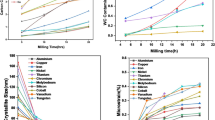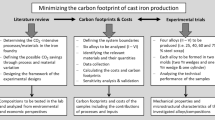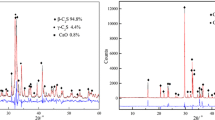Abstract
Carbon equivalent of cast iron is known as the following equation: CE = [%C] + (1/3) [%Si]. This equation is basically calculated from the carbon solubility in hypereutectic composition. On the other hand, liquidus from hypoeutectic to eutectic composition in Fe–C phase diagram is well known. Liquidus temperature (hereinafter referred to as TL) can be measured easily with thermal analysis by focusing primary crystallization temperature. In this study, the effects of elements on TL and carbon equivalent in cast iron were examined from the view point of cooling curve, carbon flotation, and internal shrinkage, and a more accurate equation for calculating carbon equivalent is suggested. It is revealed by the experiment that the relationship between TL and elements from hypoeutectic to eutectic composition is as follows; TL (°C) = 1625 − 110 [%C] − 25 [%Si] + 3 [%Mn] − 35 [%P] − 71 [%S] − 2 [%Ni] − 7 [%Cr]. Dividing this equation by carbon coefficient, the carbon equivalent equation of liquidus (hereinafter referred to as CEL) from hypoeutectic to eutectic composition is obtained as follows: CEL = [%C] + 0.23 [%Si] − 0.03 [%Mn] + 0.32 [%P] + 0.64 [%S] + 0.02 [%Ni] + 0.06 [%Cr]. This CEL is different from the commonly used CE since it is determined from liquidus. We investigated how the difference of carbon equivalent (CE/CEL) application in the range of hypoeutectic to eutectic composition affected on the cast iron and revealed that CEL = [%C] + 0.23 [%Si] should be applicable.












Similar content being viewed by others
References
P.A. Heller, H. Jungbluth, Giesserei 42, 255 (1955)
F. Neumann, H. Schenck, W. Patterson, Giesserei 47, 1217–1246 (1959)
W. Patterson, H. Siepman, H. Paycna, Giesserei 48, 239 (1961)
T.B. Massalski, H. Okamoto, Binary Alloy Phase Diagrams, vol. 1, 2nd edn. (ASM International, OH, 1990), p. 843
H.W. Dietert, On gating iron castings. Am. Foundry Soc. Trans. 34, 1038–1048 (1926)
L.F. Porter, P.C. Rosenthal, factors affecting fluidity of cast iron. Am. Foundry Soc. Trans. 60, 725–735 (1952)
Special steel committee, Toku 33-4-ji 10, Daido steel (1967) (as cited in ISIJ, Tekko Benran, vol. 1, 3rd edn. (Maruzen, Tokyo, 1981), p. 205)
T. Kanno, J. JFS 76, 62–66 (2004)
L. Wang, H. Nakae, J. JFS 91, 213–220 (2019)
M. Hansen, K. Anderko, Constitution of Binary Alloys, 2nd edn. (McGraw-Hill Book Co, New York, 1958), p. 354
T. Kanno, I. Kang, J. JFS 85, 414–419 (2013)
T. Kanno, I. Kang, Y. Fukuda, T. Mizuki, S. Kiguchi, J. JFS 77, 9–17 (2005)
Author information
Authors and Affiliations
Corresponding author
Additional information
Publisher's Note
Springer Nature remains neutral with regard to jurisdictional claims in published maps and institutional affiliations.
Rights and permissions
About this article
Cite this article
Koriyama, S., Kanno, T., Iwami, Y. et al. Investigation of the Difference Between Carbon Equivalent from Carbon Saturation Degree and that from Liquidus. Inter Metalcast 14, 774–781 (2020). https://doi.org/10.1007/s40962-020-00430-5
Published:
Issue Date:
DOI: https://doi.org/10.1007/s40962-020-00430-5




